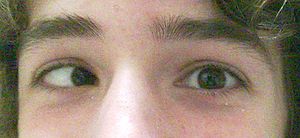
Does your Child has Squint ?
What is squint?
Our both eyes together see the world around us. As soon as we pay attention to some object in the space around us, our eyes are set on it so as to fix the object of attention with two eyes. If one eye deviates from the object of fixation, this is called squint. It is known as STRABISMUS in Medical Language.
Squint is a deviation of one of the eyes from the fixation point. Deviation from the fixation point can be temporary, permanent, or occurring in a certain direction of gaze.
How to determine if your child has squint or not?
Many a time, parents come to us thinking that the child has squint. But In fact, those are the situations where child is seeing some near or close-range objects. In such cases, one eye may be brought to the nose and the parents believe that the child is squinting. However, when we ask the parents to determine which object the child is fixing, the parents see that both eyes fix the same point in space. Hence there is no squint.
The deviation of one of the eyes from the object of fixation is a prerequisite for the existence of squint. No deviation, no squint. And for this we need to know where the child is looking.
Sometimes, It is very difficult to know if child has squint or not just from photograph. So active examination of child with doctor is a must before knowing if child has squint or not.
Can squint be normal?
Up to three months of life, the synchronicity of eye movement may be inadequate, therefore, a short-term deviation from fixation is allowed. Thats is majority of time convergent squint or INWARD squint. A slight divergent or OUTWARD squint is also allowed up to 3 months. Children with neurologic delay may have more prolonged divergent squint.
At an older age, there is no normal squint. All squint is pathological.
Can Glasses correct the Squint? or What is Convergent or INWARD Squint ?
Yes. But it depends on type of squint.
There is a type of squint known as accommodative squint, this is a squint, which is associated with an accommodative reflex (also called a reflex to near). The reflex to near is that when accommodating at a close distance, the lens increases its curvature in order to focus the eye on objects located near. This is due to the tension in the ciliary muscle. Both eyes turn inward, this one is called convergence. Convergence is needed in order to establish the direction of gaze of each eye to objects at close range. Pupils narrow, depth of field increases.
If the refraction of the eye is farsighted/PLUS Power/HYPEROPIA, then the tension of accommodation is constant, the ciliary muscle increases the curvature of the lens when fixing into the distance, and even more for near. This triggers excessive firing in the binocular reflex chain. Such impulses can lead to the development of convergent squint. Convergent accommodative squint develops more often in children with farsightedness. Typically, this squint occurs from 6 months to 2 years. With converging accommodative squint the main reason for its development, therefore, with this type of squint, spectacle correction is mandatory. You can't pull with glasses in this case. Glasses are prescribed, correcting the entire degree of hyperopia.
Bifocal glasses may be needed in cases where there is a big difference in the deviation of the eye to the nose between looking into the distance and looking up close.
Eye Gymnastics, exercise equipment, physiotherapy, with accommodative convergent strabismus is a waste of time, and unfortunately such appointments can still be found in clinics of many metro cities also.
What is Divergent or OUTWARD Squint or EXOTROPA?
Divergent squint is less common. All children with divergent squint must be evaluated by an ophthalmologist.
In the case of divergent squint, parents notice that one eye "goes to the temple" or "deviates outwards", in cases where the child looks into the distance, nowhere, or thinks. It often happens that when such a child is attracted, the squint disappears. Squint is worse when the child is tired or sick. Many children feel the eye recede to the temple and can manage this condition.
It is often the case that intermittent divergent strabismus becomes more rare with age. In most cases, it does not go away completely and can sometimes appear in cases of fatigue or illness. Factors such as fatigue, stress and illness affect the frequency of episodes of divergent, non-permanent strabismus. We must try not to expose the child to stress, fatigue and illness.
Treatment of divergent strabismus consists in correcting significant refractive errors, if any, and it is possible to prescribe occlusion. In most cases, with non-permanent divergent strabismus, visual functions do not suffer. If a divergent squint is pronounced and the child squints most of the time, this squint may affect the development of visual function. In such cases, the doctor may recommend surgical treatment.
Convergence exercises can be effective when there is a lack of convergence, but the lack of convergence can be confused with divergent, non-permanent squint. The difference may be that when there is insufficient convergence, the deviation of the eyes is more pronounced when focusing at close range.
These all details in just for basic information about the diseases. Please consult your doctor before following this by yourself. --- Dr Dhaval Patel (MD, AIIMS Delhi)
- compiled & published by Dr Dhaval Patel MD AIIMS